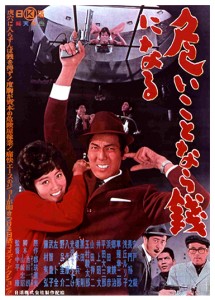AKA: Danger Paws
Director: Ko Nakahira
Cast: Joe Shishido, Ruriko Asaoka, Hiroyuki Nagato, Arihiro Fujimura, Eiji Go, Bokuzen Hidari, Kojiro Kusanagi, Torahiko Hamada, Daizaburo Hirata, Toyoko Takechi, Zenji Yamada
Running Time: 82 min.
By Kyle Warner
Danger Pays is an odd little movie. It shifts from wacky comedy to violent action at the drop of a hat. You wouldn’t know it at first, but the opening credits theme song is a pretty good indicator of what to expect from the film that follows. While the lead singer treads into dark territory with lyrics like, “Who is going to kill me?” the chorus, which sounds like an office party doing a crazy business cheer, cries out, “Danger’s where the money is!” Right after that song, we get a violent carjacking before settling into screwball territory. Tonally, this film is all over the map, but in a strange way that becomes part of its charm. Danger Pays is willing to do just about anything to get a laugh, while also not sacrificing what Nikkatsu Studio’s did best, which was delivering fast-paced action movies. It’s a dark comedy wearing the unassuming suit of a mainstream caper.
When a government shipment of watermarked paper for the treasury department is carjacked by crooks intent on making counterfeit money, Tokyo’s underworld knows that Japan’s expert counterfeiter (Bokuzen Hidari) will soon be in high demand. Hoping to make some money as an unsolicited middleman to arrange the Expert’s services, conman Glass-Heart Joe (Jo Shishido) hurries over to the airport to swoop up the old counterfeiter as he returns to the country. However, Joe’s not the only one who had the bright idea to make a quick buck, as his rivals Slide-Rule Tetsu (Hiroyuki Nagato) and Dump-Truck Ken (Kojiro Kusanagi) also show up at the airport to pick up the Expert. It’s then that the crooks appear and abduct the Expert, thus beginning a game of give-and-take as everyone races to acquire the Expert’s services and make a big payday.
Danger Pays is a movie that’s just chockfull of colorful characters, ably performed by a likable ensemble cast. Slide-Rule Tetsu played by Hiroyuki Nagato (Shinjuku Incident) is obsessed with math and the odds of every situation, constantly referring to the slide-rule in his pocket for all his important decisions. The Kojiro Kusanagi (The Warped Ones) character Dump-Truck Ken is the brute of the antihero trio, at one point torturing a bad guy by threatening to crush him with his dump-truck’s hydraulics. Joe Shishido’s performance is one of the actor’s goofiest, but he also taps into a level of charm that’s usually reserved for Japan’s more suave leading men. As Glass-Heart Joe, Shishido’s performance is part Cary Grant, part Peter Sellers, and I think fans will get a kick out of it. (I did.)
There are a few other important players without whom the movie wouldn’t be the same. Bokuzen Hidari (Seven Samurai), an actor ‘gifted’ with one of the saddest faces in the world, is lovely in his comic role as the Expert. When the crooks force him to make the counterfeit plates for them, his only request is that his working space be a “messy, noisy, and erotic place.” Ruriko Asaoka (Tokyo Mighty Guy) is a delightful addition to the cast, here playing a high-strung judo aficionado who’s happy to be part of the action even though she’s inexperienced in the criminal underworld. I’ve often seen Asaoka in dramatic roles, but seeing her in this it’s clear that she has a gift for comedy, as she gives the film some of its best laughs. Even the film’s villain (Torahiko Hamada, The Thick-Walled Room) brings some laughs to the proceedings, despite being one of the only characters that plays things straight the whole time.
As noted, Danger Pays is not afraid to get tough and bloody. The opening carjacking has enough blood to warrant it an R-rating before the stars of the film ever show their faces. Later, the violence actually borders on becoming gross, as one gag has blood dribble out of a corpse’s mouth and drip down Ruriko Asaoka’s neck. It’s surprising how much violence they fit into this, a film which is otherwise quite silly. This strange shift in tone will bother some viewers. Personally, I thought it added something to Danger Pays’ arsenal, and helped set it apart from other comedies of the time. Despite the general goofiness, I consider it something of a dark comedy. These are characters obsessed with money and guns, they kill each other in order to get what they want, and all the while the film around them mixes gallows humor with the sort of screwball comedy that was so popular in the 60’s.
Of Japan’s great directors, Ko Nakahira remains one of the most difficult for me to figure out. His masterful debut, Crazed Fruit, remains his finest film. With Crazed Fruit, Nakahira is credited for helping to create the Japanese New Wave film movement, something of a parallel to French New Wave. After that stunning debut, though, the idea of what made a “Nakahira film” was impossible to determine, as he worked across basically all genres and even did a couple films for Shaw Bros. in Hong Kong. As an artist, he was something of a chameleon. Danger Pays and the late-career pink-action Rica movies are about as different from Crazed Fruit as you can get. Passing away too soon at age 52, Nakahira undoubtedly had many more strange and colorful films to share with us. Even so, much of his filmography remains largely unseen by the Western world, so there is still much to discover, and Danger Pays is a good example of such a discovery.
Danger Pays is an oddball of a film that’s not likely going to appeal to all viewers—it’s potentially too goofy for the hardcore action fans, and too violent for those just hoping for a silly comedy. Speaking for myself, I had a good time. The cast is fun and director Nakahira infuses his movie with boundless energy. The one thing you can never accuse Danger Pays of being is a lazy film. This film works tirelessly for every laugh and shock, so even though not all of it works there’s still something to admire about how hard it tries.
Kyle Warner’s Rating: 7/10




